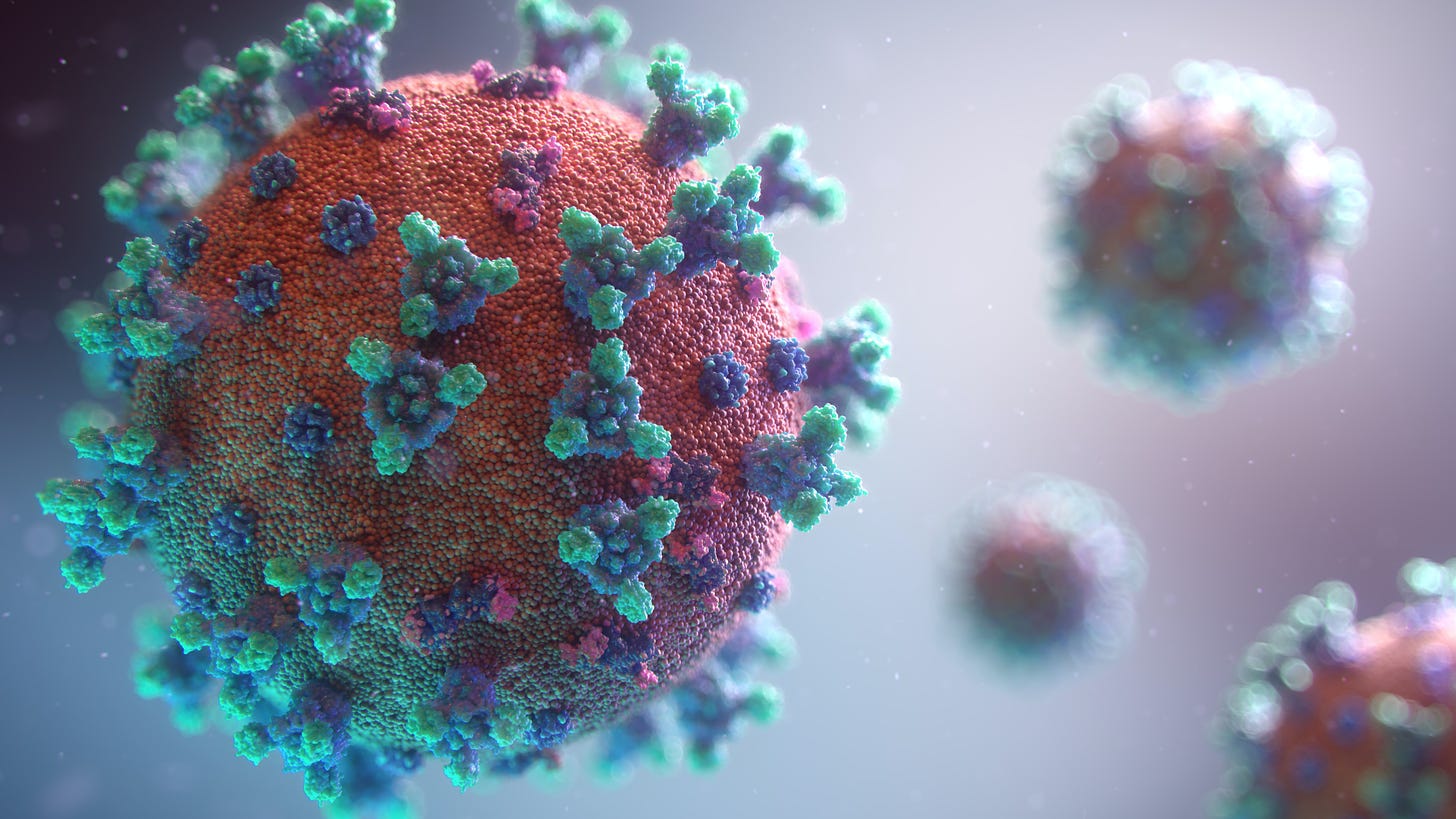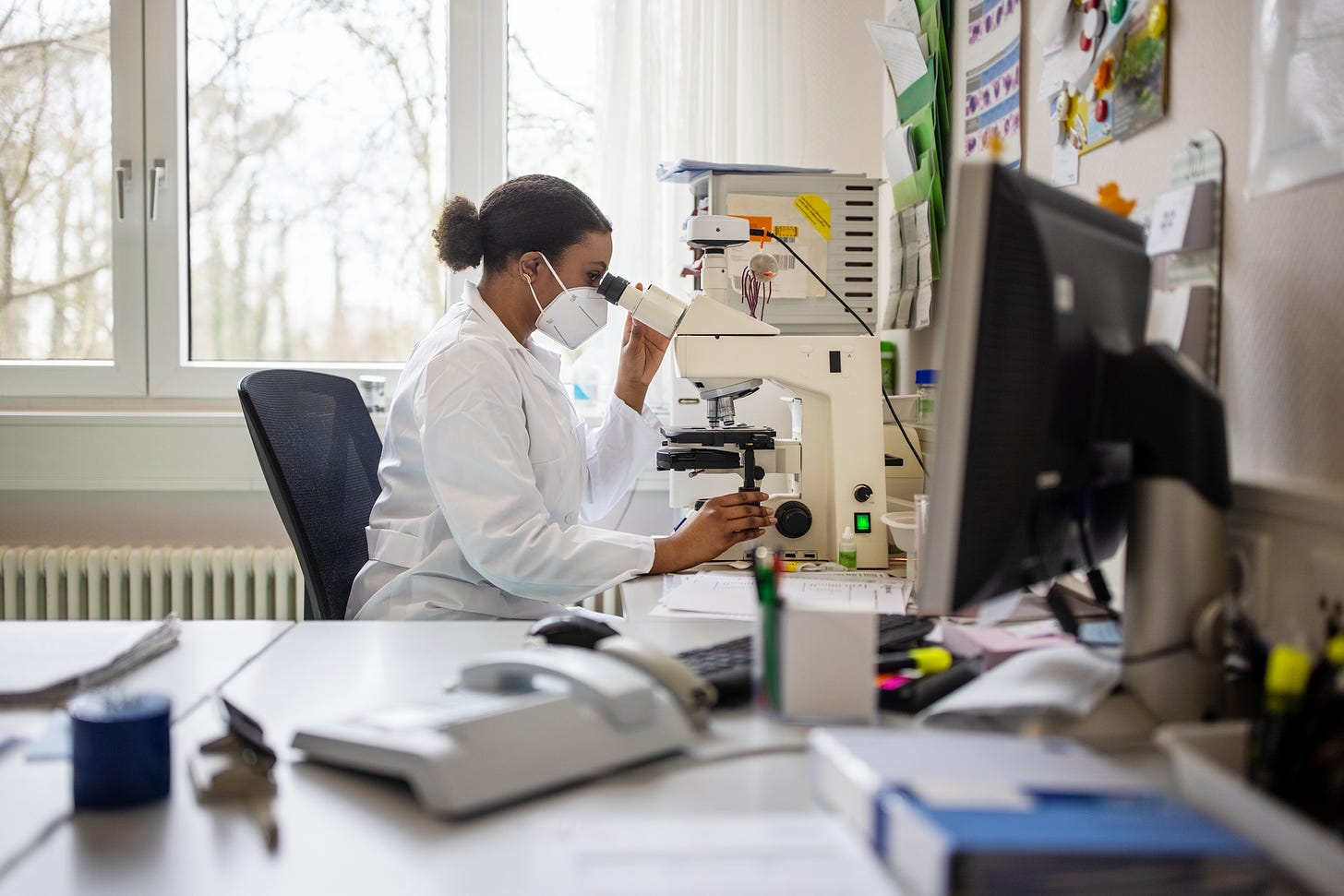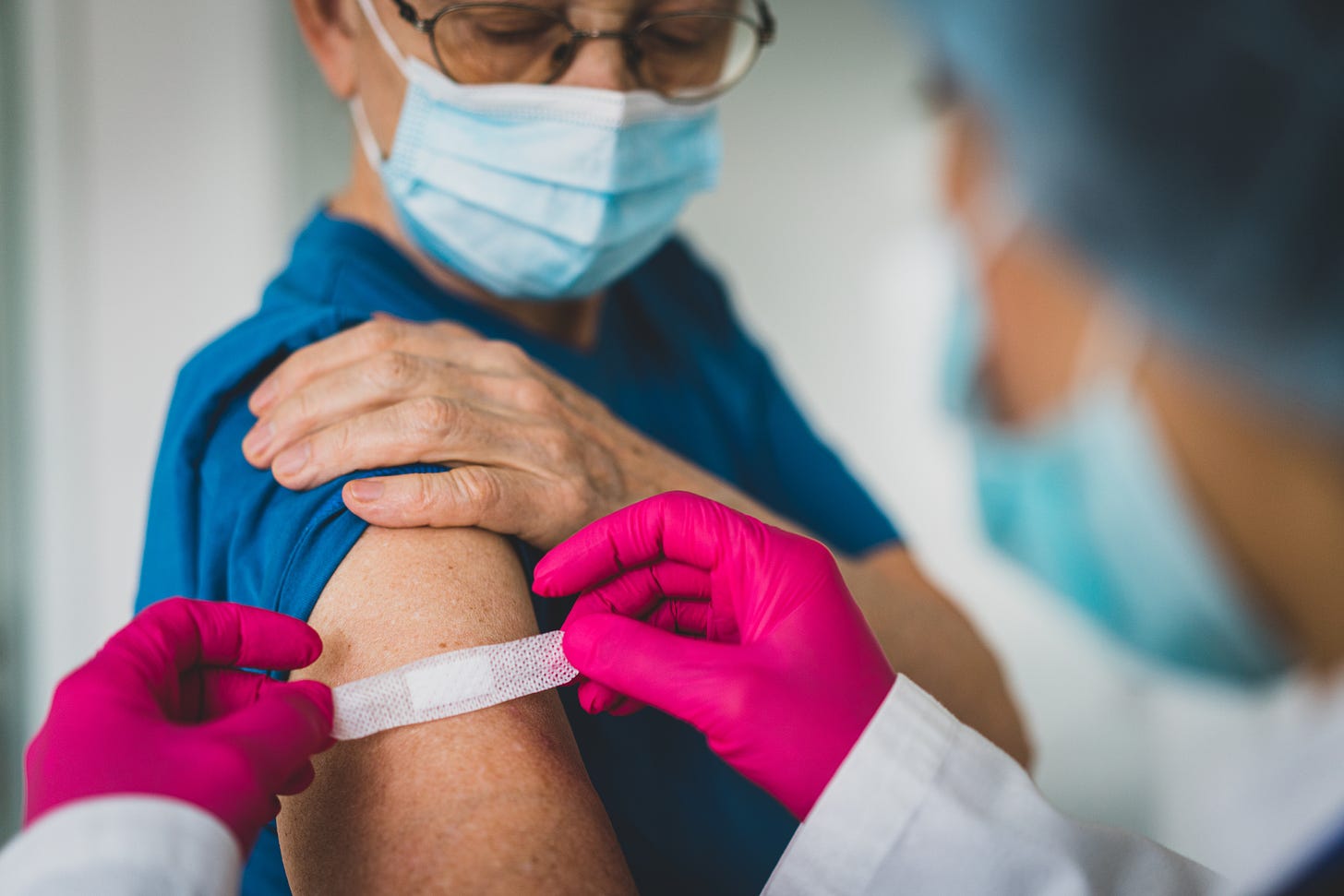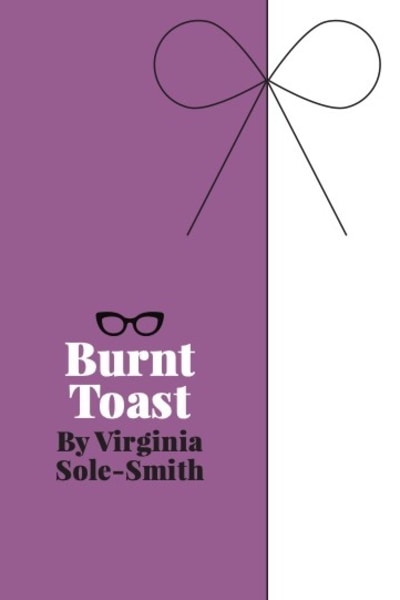Covid, Fat Cells, and Journalism's Personal Responsibility Problem
We may need this on a t-shirt: Fatphobia is always the X factor.

Q: I’m so curious what you think about the New York Times story on COVID-19 and ob*sity. I felt like the research didn’t seem compelling enough for a push news alert? (I currently have COVID-19 so I’m particularly sensitive… I have a relative who I exposed to COVID-19 who is anxious because she’s in a bigger body and it’s heartbreaking.)
So many of you wrote in with some version of this same question, so we are pausing Jeans Science to talk about actual science—or rather fatphobia in science, because as I’ve discussed so many times, that is always the X factor.
So here is the NYT story and here is the study they reported on. I share those links with all of the warnings because both include the o-word and lots of other stigmatizing language.
The most important thing to know about this research: It’s only up on a preprint server, meaning it hasn’t been published in a scientific journal. The draft paper comes with a giant yellow warning box on the top, noting that it has “not been formally peer-reviewed and should not guide health-related behavior or be reported in the press as conclusive.”
There are many other red flags about this research, and Christy Harrison did a beautiful job of running them down in her newsletter last week. For starters, these researchers studied exactly 11 people, using cell samples from three living volunteers and the autopsies of eight deceased people. Of those subjects, seven were over the age of 65. As Christy notes: “We know that age is a major independent risk factor for severe Covid-19 outcomes, and yet the researchers don’t control for age when making pronouncements about the role of fat tissue in Covid.”
And neither the researchers nor the media coverage acknowledge the fundamental limitations of studying health via fat cells. “I’m always wary of studies of fat cells for the simple fact that those cells come from *people* whose stress/inflammatory responses were inevitably shaped by the conditions of their lives (likely including weight stigma and other forms of discrimination, weight cycling, disordered eating, etc.),” Christy writes. “And yet researchers treat these disembodied cells as somehow more ‘objective’ than studies in living human beings.”
They do this because what they don’t do is question their base assumption: That fatness, always and incontrovertibly, equates with poor health. As I explored in this essay, this anti-fat mindset underpins all of modern medicine:
…Everything we know about weight and health has been underwritten by our pervasive cultural bias against fat people. You don’t have to throw out all of those decades of research, but it is useful to look critically at how that research got done and consider how useful it can be, given this huge limitation of bias. [...] Fat bias shows up in the questions researchers ask and don’t ask. It shows up in how they frame their findings. It shows up in how the media covers their research.
So now, let’s talk about the media part. Health and science journalists have a clear ethical obligation not to report on preprint, non-peer-reviewed research. I’m not going to say I’ve never done it because that will inspire someone to dig up a time I did. And the pressure from editors and publications can be so intense to find a piece of research that feels new and surprising and translatable into good writing and a great headline. So often, ethics be damned, we do report on preprints and justify that decision with one quick disclaimer line in our set-up, which is what this NYT reporter did. But we all know: Most readers miss the disclaimers. Most readers don’t read past the headline, or, in the case of this piece, the breaking news alert the NYT sent out. (Preprint research is not breaking news! It is not even news yet! It should be left unbroken!)

There is also an important distinction to be made between reporting on a preprint because the research is suggesting exciting avenues for further research and reporting on a preprint in a way that immediately prompts readers to take some kind of action. Running a story with a lead quote of “‘Oh my god, indeed, the virus can infect fat cells directly,’” is going to make people think they have to lose fat cells to prevent COVID-19. Especially if you’re running said story right now, in December, as Omicron is raging, and our holiday-related weight anxiety is spiking, and the specters of New Year diets loom. And especially if you have spent an entire pandemic stoking our anti-fat bias with headlines about weight as a COVID-19 risk factor and the “quarantine fifteen.” (I’m not going to re-hash each of those today.1)
Journalists on the health or science desk of a place like the NYT, which publishes so many stories every day, often lose sight of the bigger context of their work. They’re going from one urgent news story to the next, and the degree of urgency matters tremendously because if it doesn’t feel urgent, they won’t be able to fight for space. (We used to call it column inches, now it’s more about home page visibility.) But the bigger context is essential. The NYT piece focuses entirely on the study’s (again, non-peer-reviewed, unpublished) findings and then asks researchers in the field to speculate about why coronavirus might “hang out” in fat cells and how this could explain why folks in larger bodies have a higher risk for severe illness and death from COVID-19. But it doesn’t explore any other theories or explanations for this relationship. It makes a one passing reference to race:
Black, Hispanic, Native American and Alaska Native people in the U.S. have higher obesity rates than white adults and Asian Americans; they have also been disproportionately affected by the pandemic, with death rates roughly double those of white Americans.
And then jumps back to a researcher saying, “This could well be contributing to severe disease.” There is no discussion of the many other shared factors contributing to severe disease here. The most glaring omission: The fact that people of color and people in larger bodies have less access to healthcare and receive worse medical care when they can access it, compared to their thin, white counterparts.
I’m not saying a biological relationship between fat cells and COVID-19 doesn’t exist. But when we focus solely on nailing down this relationship, we ignore the very real harm caused daily by the many forms of stigma that pervade the healthcare system. We ignore the larger structural inequities that inform a person’s health status and instead reinforce the myth that health and weight are both personal improvement projects that anyone can undertake if they just want it badly enough. Invoking “personal responsibility” instead of pushing for systemic change is how Americans take our healthcare.

The great irony to the personal responsibility conversation, of course, is that there are clear and simple steps we can all take to prevent transmission and reduce the severity of COVID-19, yes even now in the Age Of Omicron: Wear masks, get tested when symptomatic or before large gatherings, and for the love of God, get vaccinated and boosted. All of these strategies have large amounts of data documenting their safety and efficacy, unlike, say, weight loss, which doesn’t work for the vast majority of people. Rather than singling out or blaming already marginalized groups, we could just all do what research has actually shown works. It is not the fault of NYT, or this health reporter that we’re not. Indeed, NYT has done some of the best and most convincing coverage on the importance of masks and vaccines. But media coverage that zeros in on COVID-19 and fat has a way of further narrowing the lens of folks who have decided they don’t need to care about this. Because we blame people for their body size, deciding that fatness increases COVID-19 risk makes it possible for people to say: Well why should I change anything when these people won’t help themselves?
Back in the early 2000s, I worked at a now-defunct eco-lifestyle magazine for women called Organic Style. We were kind of a proto-Goop, but published by Rodale so a lot less stylish. And we were obsessed with toxic chemicals in consumer goods, and helping readers choose eco alternatives to their cleaning products, beauty products, and furniture. To be honest, I’m already exhausted remembering this. Toxic chemicals in consumer goods were and are a concern—but it requires tremendous industry overhaul and increased regulations to change. We would encourage people to write their representatives, sure, but mostly we talked about how to do “just one thing” and shop your way out of the problem. Which is a neat way of blaming consumers for buying the wrong thing, when the “right” thing costs three times as much, is difficult to source (and almost certainly doesn’t come in plus sizes). So that was all fraught enough. Then a new health editor joined the staff, fresh from another women’s magazine and newly radicalized about eco-health isues. She found a bunch of studies, much like this new COVID-19 study, showing how BPA, phthalates, and other estrogen-mimicking chemicals accumulate in…you guessed it, fat cells. And our editor-in-chief’s response was to assign a weight loss story. Because now fat cells weren’t just unsightly; they were also “making you toxic.”
I’m hoping I don’t actually have to unpack all the ways in which that story (both the anecdote and the feature we ran) was flawed, irresponsible, and a wild misinterpretation of some extremely limited science. But here we are, almost 20 years later, with the New York Times health section —not Goop, not a lady mag, the gray lady herself!—doing the COVID-19 version of that same story. So in case it’s not clear: Your body is not toxic. We have no evidence that losing fat cells will reduce your risk of long Covid. But yet again, we can see the harm caused when journalists cover weight and health without any examination of our own biases.
Virginia Edit, 12.23.21:
Several astute readers noted that in addition to the points made here — the entire concept of “lose your fat cells” is wildly inaccurate. I’m printing with permission, this note of clarification from science journalist Bethany Brookshire, PhD:
When people lose body fat, they lose fat cell mass, but the number of adipose cells (to my knowledge, anyway), stays constant in adulthood:
Here we show that adipocyte number is a major determinant for the fat mass in adults. However, the number of fat cells stays constant in adulthood in lean and obese individuals, even after marked weight loss, indicating that the number of adipocytes is set during childhood and adolescence.
They turn over, get larger or smaller, but in general the number of them does not change. It's really weirdly tightly regulated actually. Fat cells, are, above all things, energy storage units. They can store stuff and get larger, but you don't generally add cell number. It makes sense, honestly, because it requires way more energy to grow a new cell than it would to store energy in an existing cell. For energy storage, efficiency matters. (It also makes a lot of sense for why it's so easy to regain any lost weight on a diet).
And that makes the paper and media coverage even worse. Because it then suggests somehow that people with fewer fat cells, something determined, if at all, by your childhood and adolescence, will somehow get less sick? The paper doesn't even say that, but the coverage does, and that's both gross and also most likely entirely wrong. There's no proof of that! The whole thing has no reason to receive coverage. What would SARS-CoV-2 infection in fat cells even mean? Do we have proof it matters on a physiological level? Lots of other things 'hide out' in different tissues.
Calling all feeding professionals (especially dietitians!): I’ll be presenting a webinar on Diet Culture at the Family Table on January 12 as part of Responsive Feeding Pro’s new continuing education program. Come join us! If you can’t make it on that day, you can still register and download the video to watch later, along with their many other excellent course offerings.
The gift of good email! If you have anyone in your life who needs to join the Burnt Toast community – you still have time to get a gift subscription for a holiday gift! You can schedule it to arrive any day you like. And here’s that pretty gift certificate you can download, print and fill out for them:
PS. You may have noticed this email arrived much earlier than usual today! I took a poll on Instagram last week, and got lots of votes for both essays and podcasts arriving early morning (Eastern Time). I’m personally on the fence; I like getting podcast episodes early so I can listen during my morning workout or driving time, but I’d rather get essays around lunchtime so I can take my break with them. But honestly, it’s up to y’all. So if you have strong feelings about email delivery time, please post a comment or hit reply and let me know.
In case you want to re-hash: Here’s the role that fatphobia plays in the covid-weight link. Also this one. Here’s what you need to read about your pandemic weight gain. And here’s what to read about your kids’ pandemic weight gain and how they’re eating during the pandemic.





Thank you! 💓
It sounds like such irresponsible journalism. I’m sure it got the clicks they were after though.